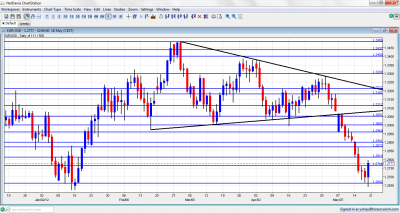Euro/dollar had a horrible week, with drops accelerating on the certainty of another round of Greek elections, and open talk about a Greek exit of the euro-zone. The pair avoided falling below this year’s lows for now. Are more drops likely, or are we in oversold territory? Here is an outlook for the upcoming events and an updated technical analysis for EUR/USD.
Apart from Greece, also Spain is struggling with higher yields (and a bottomless banking sector) and the Italian economy is squeezing quite rapidly. Italy is currently on the back burner due to Spain and Greece, but Italy and its banks could return to the limelight sooner than later. The only good news came from Germany, whose growth saved the euro-zone from technical recession. But will Germany use its economic strength to keep most of the euro-zone intact? Up to now, the answer has been No. Things could change.
Updates: There are no economic releases out of the Euro-zone as we start the trading week. After last week’s sharp drops, EUR/USD is trading in a narrow range. The pair was trading at 1.2770. Traders should not count on a quiet week, however. In Greece, the June election could turn out to be a referendum on continued membership in the Euro, and there is more talk of a bailout for Spain. Stay tuned, as events are unfolding almost every day. There is only one release scheduled on Tuesday, Consumer Confidence. The market estimate stands at -20, unchanged from the April reading. With the turmoil engulfing Greece and Spain, traders shouldn’t expect any dramatic improvements in this consumer indicator. An crucial EU Summit is taking place on Wednesday, and the markets are hoping for some tangible results. All eyes will be on Germany’s Merkel and France’s Hollande, who must quickly iron out their deep differences on how to best fix the ailing Euro-zone. EUR/USD is steady, and was trading at 1.2752. Euro-zone Current Account was outstanding, hitting 9.1 Billion. This was the best reading in years, and easily exceeded the market forecast of 6.0B. Euro-zone Industial Orders was also strong, jumping 1.8%. The market estimate called for a drop of 0.1%. The euro continues to slide, and it will take more than a couple of strong economic indicators to prop up the currency. All eyes are on today’s EU Summit in Brussels, but it is questionable if there will be any tangible results from the meeting. EUR/USD was down, trading at 1.2661. The pair is trading at its lowest level, since January. An unenthusiastic EU Summit did little to calm market jitters about the debt crisis and possible Greek exit from the Euro-zone. Germany is cool to the French proposal to introduce joint Euro bonds, and about the only item the Summit leaders could agree on was a plea to Greece to honor the bailout agreeement and implement austerity measures. About the only German economic data was weak, as IFO Business Climate and Manufacturing PMI fell below the market forecasts. Look for the euro to take an even worse beating if German data continues to disappoint the market. EUR/USD was trading at 1.2572. The euro has had a brutal week, shedding about two cents in value against the US dollar.
EUR/USD daily chart with support and resistance lines on it. Click to enlarge:
- Consumer Confidence: Tuesday, 14:00. This official indicator from Eurostat is stable deep in negative ground for 8 months, around -20. No change is expected. A negative numbers means pessimism.
- Current Account: Wednesday, 8:00. This is a rather late figure, but provides the “big picture” regarding flows. After two months of surpluses, a deficit of 1.3 billion euros was recorded in February. March will likely see a surplus of 3.4 billion.
- Industrial New Orders: Wednesday, 9:00. New orders at the manufacturing sector tend to fluctuate. Two months of drops will probably be followed by a third one, this time only 0.1%. A third month of drops is worrying.
- German Final GDP: Thursday, 6:00. Germany proved to be the continent’s locomotive once again. According to the initial growth figures, Europe’s No. 1 economy surprised and grew by 0.5% in Q1 2012. This will likely be confirmed now. This strong growth rate helped the euro-area escape a technical recession, with 0% growth in Q1.
- Flash PMIs: Tuesday, France begins at 7:00, Germany continues at 7:30 and data for the whole continent is released at 8:00. The purchasing managers’ indices are highly important as they are forward looking. In April, PMIs turned lower, indicating a deeper recession in Q2. Out of the 6 indices, only Germany’s services sector is in growth territory, above 50 points – this will likely weaken now. Yet German manufacturing nearly at a 3 year low. Fresh services fell to 45.2 points, and this could see a small recovery now. The figures for the whole continent are dire as well, with manufacturing at 45.9 and services at 46.9 points. Both are expected to tick up very marginally.
- German Ifo Business Climate: Tuesday, 8:00. Germany’s No. 1 Think tank printed 6 months of rises in its wide, 7000 strong survey. The score reached 109.9 last month. Yet the winds are probably changing in Germany after a strong quarter: the ZEW indicator also turned lower after a few excellent months and Ifo will likely follow and slide to 109.5 points.
- Belgian NBB Business Climate: Thursday, 13:00. Also in the capital of the EU, things continue deteriorating: this indicator fell back before reaching positive ground. A small rise from -10.7 to -9.6 is predicted now.
- German GfK Consumer Climate: Friday, 6:00. German consumers are in a less optimistic mood, with this survey of 2000 people falling to 5.6, the lowest since December. A rise to 5.8 points will probably be seen now.
* All times are GMT
EUR/USD Technical Analysis
€/$ opened the week with another gap. At first, the pair traded in a narrow range under the 1.2873 (discussed last week). It then tumbled down and even temporarily breached 1.2660 before making a last minute recovery to close at 1.2777.
Yet again, the open gap was certainly a bearish sign. Will there be another one.
Technical lines from top to bottom:
We start from a lower point this time. 1.3180 capped attempts to rise in May 2012 and is a minor line on the way up. 1.3110 is another minor line that capped the pair in January and later in April 2012 as a stepping stone for a move higher.
1.3050 worked as support in April 2012 and also in March, and is next frontier above 1.30. The round number of 1.30 is psychologically important and proved to be a place of struggle. After the downfall, the pair made another attempt to fight over this line, but this failed.
1.2960 is minor resistance after capping the pair following the downfall in May 2012. It is followed by 1.29 which provided support more than once after the fall.
Very close, 1.2873 is the previous 2011 low set in January, and it returns to support once again. This is a very strong line separating ranges, as also seen in May 2012. 1.2814 provides minor resistance after working as support in the recent fall.
1.2760 is a pivotal line in the middle of a range. It provided support early in the year and is now of high importance. 1.2660 was a double bottom during January and the move below this line was not confirmed.
1.2623 is the current 2012 low and has a growing role now – a cliff. Below, 1.2587 is a clear bottom on the weekly charts.
The round number of 1.25 is of psychological importance, although not so much on the technical level. Another round number is the next support: 1.24.
Further below, 1.2330 is another historical line.
Steep Downtrend Channel Emerging
After uptrend support was broken, a steep downtrend channel is emerging. The pair is now close to the top of this channel, as the chart above shows. This will be interesting to watch.
I remain bearish on EUR/USD
Even if pro-bailout parties win a landslide victory, the current deadlock is already taking its toll: Greeks are deferring tax payments and withdrawing money from banks. Also privatization is stuck and the country didn’t receive the full tranche of aid. On this background, there is open talk about the dreaded euro exit and contingency plans. Such a “Grexit” will be a huge blow for the euro, at least in the short term. Here’s how to trade the Grexit with EUR/USD.
Spain’s banking issues and Italy’s fast squeeze of the economy are serious worries, even before the Greek domino hits them. As long as the talk about QE3 remains subdued, the euro-zone’s troubles, have more downside potential.
If you have interest in a different way of trading currencies, check out the weekly binary options setups, including EUR/USD, GBP/JPY and more.
Further reading:
- For a broad view of all the week’s major events worldwide, read the USD outlook.
- For the Japanese yen, read the USD/JPY forecast.
- For GBP/USD (cable), look into the British Pound forecast.
- For the Australian dollar (Aussie), check out the AUD to USD forecast.
- For the New Zealand dollar (kiwi), read the NZD forecast.
- For the Swiss Franc, see the USD/CHF forecast.
- USD/CAD (loonie), check out the Canadian dollar forecast.

